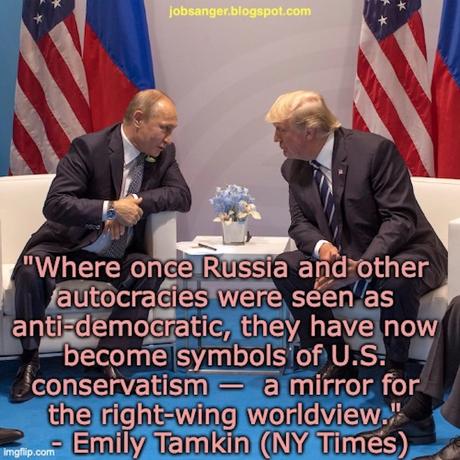
In the past, the American right-wing has been very critical of Russia (and before that the USSR). That is no longer true. They now see Putin and other authoritarians as role models.
Here's part of what Emily Tamkin had to say about this in a guest post in The New York Times:
The American political right was long associated with Cold War hawkishness. But in recent years the trend has shifted toward fawning praise for autocrats, even those leading America’s traditional adversaries, as well as projecting our own culture wars overseas. Where once Russia and other autocracies were seen as anti-democratic, they have now become symbols of U.S. conservatism —a mirror for the right-wing worldview.
Supporting Mr. Putin, as well as other authoritarian leaders, is yet another way in which the political right is weaponizing culture wars to further divide Americans.
Part of this new paradigm is that foreign policy is now a partisan matter. In 2016,Prime Minister Viktor Orbán of Hungary offered an endorsement of then-candidate Donald Trump, admiration that was later returned. Mr. Putin’s Russia reportedly meddled in the American election in 2016, and the Russian president has admitted that he wanted Mr. Trump to win. Those amicable relationships trickled down to the Republican voting population, which shifted its views on Mr. Putin’s favorability, which soared from a mere 10 percent in July 2014 to 37 percent in December 2016. A Yahoo News/YouGov poll from January of this year found that 62 percent of Republicans and Republican-leaning independents consider Vladimir Putin a stronger leader than Joe Biden. . . .
Many of the admirers of the world’s strongmen on the American right appear to believe that the countries each of these men lead are beacons of whiteness, Christianity and conservative values. On Wednesday, conservative commentator Rod Dreher wrote, “I adamantly oppose risking the lives of boys from Louisiana and Alabama to make the Donbass safe for genderqueers and migrants.”
These comments, from the right, aren’t exactly advancing a new position. In 2018, the political commentator Pat Buchanan said that Mr. Putin and the Belarusian dictator Alexander Lukashenko were “standing up for traditional values against Western cultural elites.” . . .
Russia is neither all white nor all Christian — it is a country that encompasses several regions, religions and ethnicities. Still, it is often perceived as white. The white nationalist Richard Spencer has referred to Russia as “the sole white power in the world.” Matthew Heimbach, a founder of the Traditionalist Worker Party who was involved in the 2017 Unite the Right rally, has expressed admiration for Mr. Putin and ultranationalist European political leaders. “Russia is our biggest inspiration,” Mr. Heimbach told The Times in 2016. “I see President Putin as the leader of the free world.” As The Times reported at the time, this construction of Mr. Putin as a beacon of far-right values began with the ultra-far-right nationalists in Europe and later spread to the United States.
But, as the Washington Post opinion writer Christian Caryl wrotein 2018, just as the halcyon image American Communists had of Stalinist Russia in the early 20th century belied the truth of a brutal regime, the Russia celebrated today by conservatives is also, in some ways, a fiction.
In any event, Mr. Putin is not waging a culture war. He is waging real, actual war, in which real, actual lives are already being lost.But then, why would that matter? The Russia, Ukraine, Hungary and Belarus of conservative pundits’ imaginations are just that: imaginings. Avatars. Projections of themselves. The Russians and Ukrainians who are living — and dying — do not factor into the picture.

